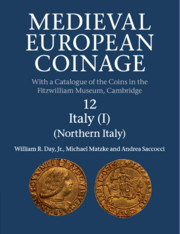Nomenclature
Published online by Cambridge University Press: 11 May 2017
Summary
PROPER NAMES
The difficulties inherent in selecting the most suitable forms for personal and place names in a reference work of this sort are discussed in MEC 1, xxi; MEC 14, xix–xx; and most recently in MEC 6, xxvi–xxxi. In this volume, the approach differs from the one adopted for MEC 1 and 14 in that English is used for personal names only for kings, emperors and popes. For the most part, other individuals are referred to by the ‘national’ forms of their names, which has become more common in the literature in English over the past few decades. Most rulers in northern Italy during the period under consideration are thus identified by the modern Italian forms of their names, but there are some notable exceptions. Foreign rulers who exercised authority over parts of northern Italy at one time or another are identified either by the national forms of their names or, in the case of foreign kings or emperors, by the English equivalents. The Angevin kings of Naples who governed parts of the Piedmont in the thirteenth and fourteenth centuries and the kings of France who sometimes ruled over Asti, Genoa and Milan are thus identified by the English forms of their names. In some cases, however, it is more appropriate to identify local rulers in northern Italy by their German names. The early patriarchs of Aquileia and the counts of Gorizia and Tyrol were Germanic and ruled over parts of northern Italy where Germanic peoples probably made up significant proportions of the population. In Italy's South Tyrol, even today, some three-quarters of the inhabitants speak German as their first language.
For place names, common English forms are used whenever they exist – such as Genoa rather than Genova, Milan rather than Milano, Venice rather than Venezia and so on – but conventional modern forms are otherwise used. This volume therefore uses the modern Cortemilia instead of the older form Cortemiglia, which is perhaps more familiar in the numismatic literature, and Masserano instead of the now antiquated Messerano. In discussing the coinage of the counts of Tyrol, both German and Italian forms are often given for the places covered, first the German and then the Italian in brackets since German was and still is the predominant language in the region.
- Type
- Chapter
- Information
- Medieval European Coinage , pp. xxiii - xxviiPublisher: Cambridge University PressPrint publication year: 2016

